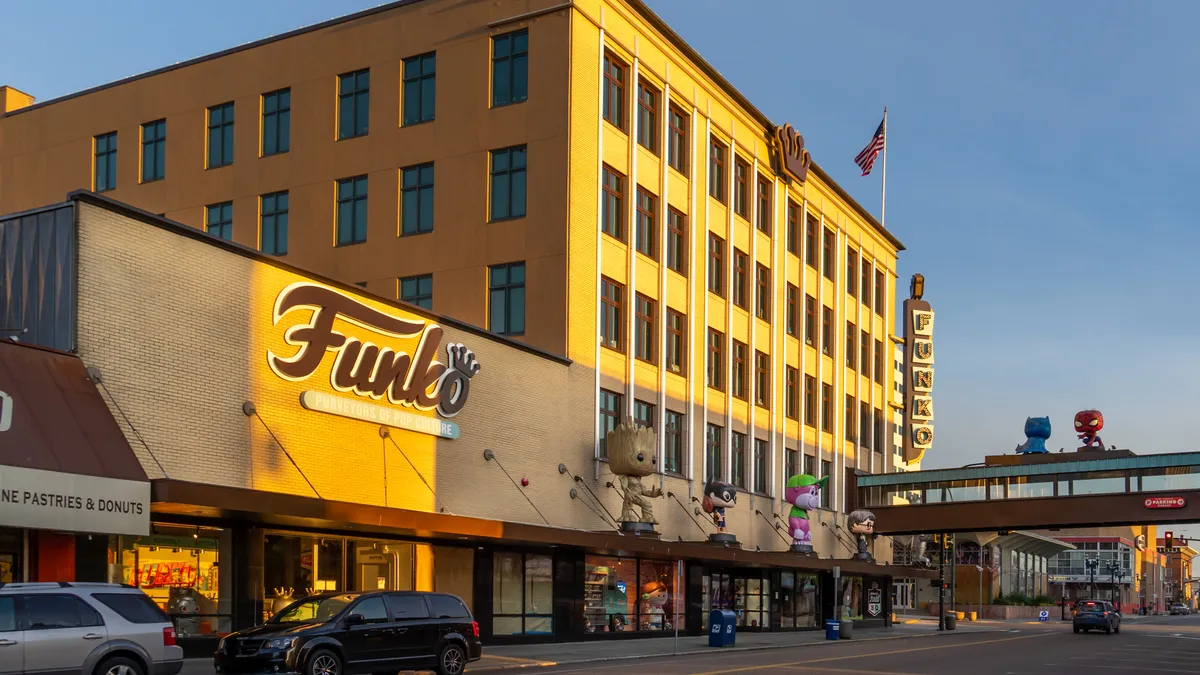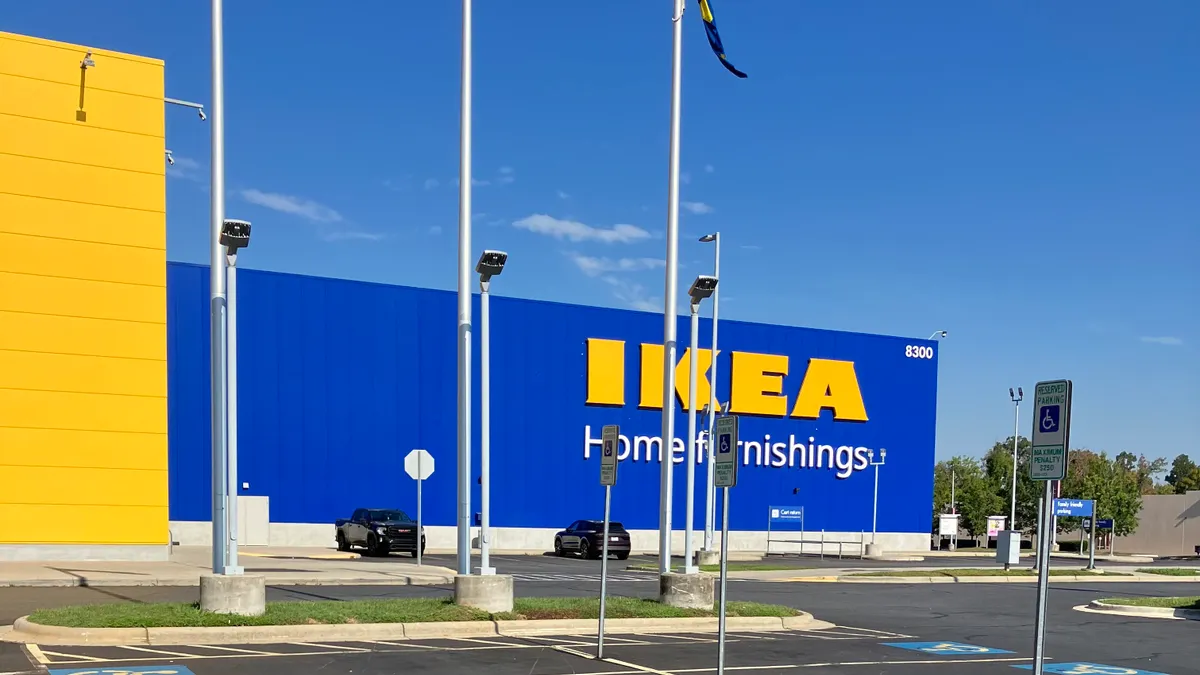Since filing for bankruptcy, J.C. Penney executives have painted a picture of a hobbled retailer that was on the mend before the COVID-19 crisis hit.
"Before the pandemic, the Company had a substantial liquidity cushion, was improving its operations, and was proactively engaging with creditors to deleverage its capital structure and extend its debt maturities to build a healthier balance sheet," CFO Bill Wafford said in court papers. "Unfortunately, that progress was wiped out with the onset of COVID-19."
He added that "now, the Company is unable to maintain its upward trajectory" through its turnaround plan, which is meant to refocus the 118-year-old store chain around its customers and retail fundamentals. On Friday evening, just after Penney filed, CEO Jill Soltau said in a public statement, "Until this pandemic struck, we had made significant progress rebuilding our company under our Plan for Renewal strategy — and our efforts had already begun to pay off."
For Penney, like scores of its peers, the pandemic meant closed stores, cratering sales and furloughed employees. Wafford said that its April sales were down approximately 88% year over year, with stores sales decreasing to nearly zero.
Prior to the crisis, the company made some modest improvements on metrics like adjusted EBITDA, but the retailer's sales declines and profit losses continued through last year, and some analysts were skeptical about the retailer's prospects for a turnaround, even when Penney operated in a good economy with a confident consumer and no pandemic crisis on anybody's horizon.
"Even before the pandemic, JC Penney's road to reinvention was the equivalent of climbing a steep mountain with nothing other than the burden of an enormous pile of debt," Neil Saunders, managing director of GlobalData Retail, said in emailed comments. "The coronavirus crisis effectively broke the retailer's limbs making further progress all but impossible."
Saunders called the company's bankruptcy filing "inevitable" after "a long period of decline." The question now is whether Chapter 11 will finally reset Penney, giving it a cleaner slate, with less debt and fewer stores, or whether Penney's decline will continue after bankruptcy — if it does indeed make it out of the process intact.
Wafford said the company, prior to the pandemic, had been talking with its lenders to try to restructure "on its own terms" its debt load — about $4.9 billion in funded debt. Its balance sheet had been an albatross for the company trying to modernize and turn itself around in an era when traffic to malls has been on a steady decline.
Debt relief, with contingencies
Wafford said Penney and its lenders "came very close to agreement on a deleveraging transaction," and then the COVID-19 crisis hit. The disruption "massively accelerat[ed] the need for a long-term deleveraging transaction coupled with a critical liquidity infusion into JCPenney's operations," he said.
The CFO made the pitch that the tools available to it in Chapter 11 would put the company "on a long-term path to success." Indeed, he said the company had proposals for out-of-court deals that would help it address some of its debt maturities, but they would have put liens on some of Penney's assets and managed to increase its interest payments. Wafford called the proposals "short-term fixes that would do nothing more than minimally extend JCPenney's liquidity runway in exchange for relinquishing assets that have served as a critical piece of value in the Company's restructuring negotiations."
So Penney filed for bankruptcy, with an agreement drawn up with a group of lenders that would remove most of its debt and, in the best of cases, put Penney back on its turnaround path with a clean balance sheet.
But it's not quite that simple. The company's agreement with lenders is predicated on a speedy journey through bankruptcy, so as not to drain money out of the company in the Chapter 11 process, which easily racks up tens of millions of dollars in fees to lawyers and consultants. It requires Penney and a majority of key lenders to agree on a go-forward business plan by July 14. That's two months during an unprecedented economic and public health crisis that makes strategizing and forecasting — even beyond the next few weeks — extremely difficult if not outright impossible.
While Penney eyes reorganization, it also plans to spin off some real estate into a real estate investment trust (REIT) and to market test bids for financing, both debt and equity, for the reorganized company, as well as bids for "some or all" of its assets. (Already speculation on who might be interested is heating up, with Amazon making headlines as a reported prospective buyer, as well as Simon Property Group and Brookfield.)
The agreement also allows for the liquidation of Penney's assets if certain milestones aren't met, namely the agreement on a business plan in July and the commitment of third-party financing by August, which again certain lenders have to deem "acceptable."
In other words, Penney's path through bankruptcy is far from certain, despite executives' optimistic tones.
The 'best case'
Cowen analysts said in an emailed note that, in the "best case scenario," Penney's restructuring agreement with lenders "should give the company greater financial flexibility by reducing financial leverage, put JCP in a stronger place to negotiate closings and rent expense, and drive the acceleration of prior operational and strategic plans."
In looking ahead at executing its turnaround plan, the company is focused, among other things, on its brand recognition, a loyal customer base it estimates at around 32 million, services like curbside pick up and buy online, pick up in-store (BOPIS), and resetting its merchandising — with a focus on women's apparel and better curation.
Should it successfully reorganize, the retailer has a plan to scale down its physical footprint by about a third. In a securities filing, Penney revealed a plan to reduce its footprint from 846 stores to just over 600, something the bankruptcy process would allow it to do in a matter of months.
Saunders called the "closure of underperforming and bad space" an immediate priority. "JC Penney is exposed to a high number of weak malls and locations and it needs to quickly cut its losses," he said. "It will emerge a much smaller company, but this makes the process of reinvention much easier and will allow capital investments to flow to locations where they can generate the best return."
Shedding stores and debt, necessary and important as they are, may be among the easiest things Penney would need to do in a turnaround scenario. "The reality on the ground, is that JC Penney needs a complete overhaul in terms of its assortments, store designs, ways of marketing and connecting with shoppers, and its brand image," Saunders said. "In other words, a wholesale makeover is required to restore the company's fortunes."
Penney has struggled for years in balancing the needs of its core customer against the need to expand traffic to its stores, of hitting the right note on merchandising, of losing market share and margins to off-price and online apparel sellers, and the list goes on. And on.
Penney is by no means alone on those counts. Even department store peers like Kohl's and Macy's, with relatively healthy balance sheets that have had the financial resources to make investments in their e-commerce and omnichannel operations, have struggled. And they struggled in years of a booming economy.
Bob Hoyler, a senior research analyst at Euromonitor International, said in emailed comments that even before the pandemic "JC Penney was already facing an existential threat to its business due to the precipitous decline of the US department stores channel as a whole." Hoyler pointed to the rise of e-commerce as one of the main reasons for the shift away from department stores. "JC Penney actually embraced e-commerce earlier than most other US department store chains, but the company did not capitalize on this head start," he said.
Others trace the company's decline to forces that were in motion much earlier. Box stores, mass merchants and off price have all taken their toll on department stores, including Penney in particular.
As Wafford pointed out, the retailer has weathered more than a century, with all the downturns and international crises — including the Great Depression and two world wars — along the way. Its existential crisis today may not be COVID-19, but reversing trends that have steadily eroded its sector for years before the pandemic hit U.S. shores.
With the pandemic here, the difficulty of reviving Penney is that much greater. Without bankruptcy, though, it may have been impossible.






















